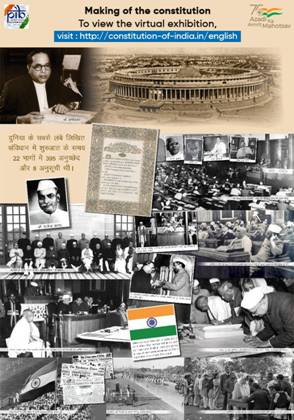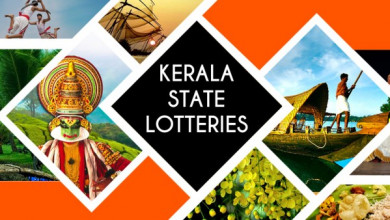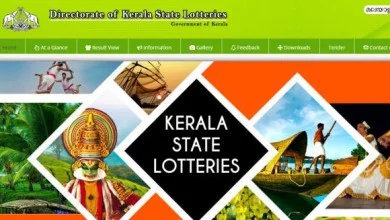Making of the Constitution- e-Photo Exhibition launched

As part of ‘Azaadi ka Amrit Mahotsav’, on the occasion of 75 years of India’s independence, Ministry of Information & Broadcasting (MIB) is launching a series of e-photo exhibitions, for an entire year, on various aspects of the freedom struggle, out of which the first one is on ‘Making of the Constitution’. The virtual exhibition was inaugurated today in New Delhi.
The e-Photo Exhibition depicts the framing of the Constitution supported by nearly 30 rare pictures. It also has links to videos and speeches which are sourced from AIR archives and Films Division. The e-photo exhibition traces the entire journey, right from the formation of the Constituent Assembly to the adoption of the Constitution and finally celebrating the first Republic Day of India.
The exhibition is available at https://constitution-of-india.in/
Key-highlights of the e-Photo Exhibition
The e-Photo Exhibition begins with the image of the Indian Parliament which represents the Constitution and of Dr. B.R. Ambedkar, who is known as ‘the Father of the Constitution’, because of his immense contribution in the making of the Constitution.
Formation of the constituent Assembly (6 Dec, 1946) and the first meeting of the Assembly (9 Dec, 1946)-The Constituent Assembly which is a body of popularly elected representatives assembled for the purpose of drafting or adopting the Constitution, met for the first time on 9 December 1946.
Dr. Rajendra Prasad Appointed as the President (11 Dec, 1946)– Dr. Rajendra Prasad, an Indian independence activist, lawyer, scholar, who would, in 1950, became the first President of India, was elected the first President of the Constituent Assembly.
Proposition and adoption of ‘Objective Resolution’ (13 Dec, 1946)-The ‘Objective Resolution’ was moved on December 13, 1946 by Pandit Jawaharlal Nehru, which provided the philosophy and guiding principles for framing the Constitution and later took the form of Preamble of the Constitution of India.
National Flag Adopted (22 July, 1947)-The National Flag of India was adopted during a meeting of the Constituent Assembly held on 22 July 1947, and it became the official flag of the Dominion of India on 15 August 1947. The Flag of India constitutes of tricolour, i.e., saffron, white and India green; with the Ashoka Chakra, a 24-spoke wheel, in navy blue at its centre.
Independent India (15 Aug, 1947)– On this day, the power from British Empire was handed over to India, through the cooperation of several freedom fighters whose efforts made independence a reality for India.
Drafting Committee (29 Aug, 1947) -The Constitution was drafted by 299 delegates from different caste, region, religion, gender, etc. The Drafting Committee and its members were very influential in Indian Constitution- making during the Committee stages and the deliberations of the Constituent Assembly.
The Constitution of India was passed and adopted (26 Nov, 1949)-This day is known as the Constitution Day or the National Law Day, is celebrated to commemorate the adoption of the Constitution of India. This constituent Assembly came into effect on 26 January, 1950.
Last meeting of Constituent Assembly (24 Jan, 1950)-Last meeting of the Constituent Assembly. ‘Constitution of India’ (with 395 articles, 8 schedules, 22 parts) was signed and accepted by all.
When Constitution came into force (26 Jan, 1950)-The Constitution replaces the Government of India Act 1935 as the country’s fundamental governing document and the Dominion of India became Republic of India.
First General Election (1951-52)-General elections were held in India between 25 October 1951 and 21 February 1952. They were the first elections to the Lok Sabha after Independence in August 1947. It was conducted under the provisions of the Indian Constitution, which was adopted on 26 November 1949.
The e-Photo Exhibition also has an additional interactive/engaging Quiz comprising a set of 10 questions to enhance engagement of the readers and ensure ‘Janandolan through Janbhagidari’ of the citizens.
This e-Photo Exhibition is available in Hindi & English and 11 other languages (Odiya, Gujarati, Marathi, Assamese, Telugu, Kannada, Tamil, Malayalam, Punjabi, Bengali,Urdu).
The link for the same is available on the websites of MIB, BOC, PIB, DD, AIR and regional offices of the MIB and other websites of different ministries. The links will be available to local universities, colleges, schools by Regional PIB/ROB offices besides promoting them on their respective social media platforms
It will also be amplified through various social media platforms like FB/Twitter/ YouTube channels. The readers can also post or share anything related to the topic by using #AmritMahotsav



